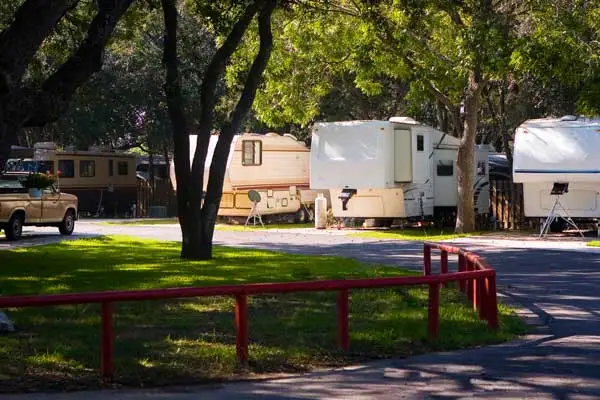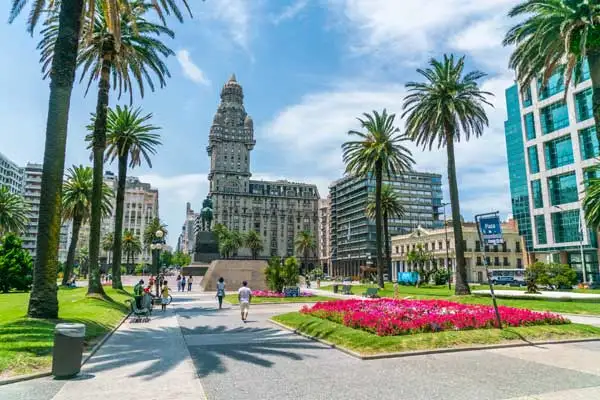Looking for an affordable adventure?
One popular option is van life. You get a cargo van, convert the interior into a camper, and take it on the open road. It’s like RV-living light.
Another option is expat life. You move to a lower-cost country that offers a climate and lifestyle you like. Favored destinations include tropical islands, Andean valleys, and a wide range of coastal destinations.
Both van life and expat life offer the opportunity to escape cold winters, discover interesting places, and meet new people. And with both options, you can do it for less than what you’d spend living a conventional life in a U.S. city.
What are the main costs of van life and expat life? And how do they measure up?
For most people, housing, transportation, and health-related costs comprise their three largest personal expenses. So, let’s do some comparing.
Major Costs of Van Life

With van life, your home and transportation costs are combined.
Housing and Transportation Costs
The first cost of van life is getting a converted van. I’ve recently seen new cargo vans for sale with a long wheelbase and high roof selling for between $45,000. and $62,000. If you finance a new van purchase, the monthly payments may run between $600 and $1,100 per month. (Actual sales prices and interest rates for financing are on the rise.)
Professionally-built van conversions can go from $30,000 to over $100,000. depending on the features, systems installed, and the quality of materials.
If you’re handy with construction, plumbing, and electrical work, you can save money by buying a used van and converting the interior yourself. You find examples of people going this route who end up with a complete camper van for around $30,000 or $40,000.
Once you've got a converted van, ongoing ownership costs include maintenance and insurance, which, together, may average a few hundred dollars per month.
A large variable cost of van life is gasoline. In many states, filling up a 24-gallon gas tank twice a week can add up to $800 per month. If you travel slowly and stay longer in places (so you just use one tank of gas per week), you can cut your gas cost down to $400 per month.
Another significant cost is campground fees. Yes, in a van you can park overnight for free on some public lands, roadside rest stops, and the parking lots of Walmart stores and 24-hour casinos.
While this can work some of the time, many van lifers spend most nights at campgrounds. It provides the convenience of outdoor space with a table, water and power hookups, and a place to dump a portable toilet.
In addition to hookups, campgrounds often include shower and laundry facilities. They’re also usually safer than free overnight parking options.
Campsites with hookups often cost between $25 to more than $45 per night. If you spent 20 nights per month enjoying a campsite at an average cost of $35 per night, it would add up to around $700 per month.
Health Coverage Costs
It’s easy to find a selection of international travel insurance policies. However, reasonably-priced insurance for full-time travel within the U.S. is difficult to come by. In fact, for many in the U.S., health coverage is the biggest obstacle to van life.
If you are over 65, Medicare with the right mix of supplemental plans may be a solution.
For U.S.-based van-lifers under 65, the best solution is often an Affordable Care Act (ACA) policy in their home state. ACA monthly health insurance premiums for adults between 50 and 64 can run between $500 to more than $1,000 per month per person, plus an annual deductible of thousands of dollars.
A downside of this option (besides the cost) is that many ACA policies require you spend more than six months per year within your state of domicile. So, for half of each year, your ability to roam could be limited.
Major Costs of Expat Life

In many attractive places in the world, your home, transportation, and healthcare costs can all be substantially less than in a U.S. city.
Housing Costs
As an example of housing costs abroad, I’ll share my experience as an expat living in Montevideo, the capital city of Uruguay.
Montevideo is a coastal city known for its tree-lined streets and large green parks. Many say it offers the highest quality of life of any major city in South America.
In many desirable parts of Montevideo, you can buy a new modern two-bedroom apartment for around $150,000. As an apartment owner, additional monthly housing costs can include property taxes, HOA fees, and basic utilities, which may add up to around $300 per month.
Another option is to rent an apartment. In Montevideo, you can find clean two-bedroom apartments for $700 per month. With HOA fees and basic utilities, your monthly housing cost may run around $900 per month.
In other parts of Uruguay, rents can be less. Maldonado is a middle-class city adjoining Punta del Este, the country's largest beach resort. And you can rent a modern apartment in Maldonado for $500 per month. With HOA fees and basic utilities, your monthly housing cost may run around $700 per month.
Get Your Free Report on the World's Best Places to Retire:
Get Your Free Report on the World's Best Places to Retire:
Learn more about the best places in the world to retire in our daily postcard e-letter. Simply enter your email address below to sign up for our free daily postcards and we'll also send you a FREE report on The World's Top 10 Retirement Havens.
By submitting your email address, you will receive a free subscription to IL Postcards and special offers from International Living and our affiliates. You can unsubscribe at any time, and we encourage you to read more about our Privacy Policy.
Transportation Costs
In many places in the world, the cost of owning and running a car can be more than in the U.S. However, in many destinations popular with expats, it’s more convenient to get around on foot and public transportation than to own a car.
That’s how it is for me in Montevideo. I do most of my shopping in the small stores and the street market in my neighborhood.
For going across town I take the bus. Buses here are clean, safe, and come by frequently. And everyone from shop workers to professionals ride them. You can go to most places in the city for about $1 each way.
So even if you went across town and back on the bus every day, your monthly transportation cost would be around $60 per month. And if on the odd chance, the bus doesn’t go where you want, you find plenty of affordable city taxis.
For traveling cross country to other cities in Uruguay and in the region, you find a network of large roomy motorcoaches. It’s the same in many Latin American countries.
Motorcoaches are roomy, with reclining seats, and large luggage bays below the passenger compartment. The cost of a two-hour- ride from Montevideo to Punta del Este is around $10 per person.
When vacationing by motorcoach, you often bear the cost of a hotel or Airbnb and restaurant meals. But in most recreational areas, you can rent affordable apartments or cabins with fully-equipped kitchens, so you can cook your own meals.
And if you ever want a car to explore off the beaten path, you can rent one for just the time you need it.
Health Coverage Costs

In many places in the world, you find responsible health coverage for much less than in the U.S.
In Uruguay, you find comprehensive health plans for $50 or $60 per month, plus small copayments when you receive medical services. And that’s without the worry of tricky terms and big deductibles.
In summary, both van life in the U.S. and expat life can cost less than a conventional life in a U.S. city. Both can be a pleasant adventure with the opportunity to experience new places and meet new people.
Between van life and expat life, which costs less? In the end, it depends on how you go about it and the tradeoffs you’re willing to make.
For me, the ideal is living in a comfortable apartment as a home base, and taking four or five trips around the country per year. (Such as a beach resort in the summer, a national park in the fall, and the hot spring region in the winter, etc.) And as an expat, I can enjoy to do just that, along with the security of quality healthcare—and for less money than what many spend on van life in the U.S.
Get Your Free Report on the World's Best Places to Retire:
Get Your Free Report on the World's Best Places to Retire:
Learn more about the best places in the world to retire in our daily postcard e-letter. Simply enter your email address below to sign up for our free daily postcards and we'll also send you a FREE report on The World's Top 10 Retirement Havens.
By submitting your email address, you will receive a free subscription to IL Postcards and special offers from International Living and our affiliates. You can unsubscribe at any time, and we encourage you to read more about our Privacy Policy.
Related Articles
Five Expat Life Lessons We’ve Learned from our Roving Retirement
